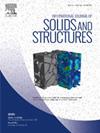Elastoplastic characterization of rolled C11000 copper sheets via a coupled calibration methodology: Experiments, modeling, and simulation
IF 3.4
3区 工程技术
Q1 MECHANICS
International Journal of Solids and Structures
Pub Date : 2025-03-12
DOI:10.1016/j.ijsolstr.2025.113314
引用次数: 0
Abstract
A comprehensive study of the post-necking response of materials is a relevant aspect in many metal-forming applications. For this purpose, the proposal of a suitable constitutive model to describe the elastoplastic response, an adequate material characterization, and the rise of numerical simulation as a feasible tool in the control and design of parts subjected to plastic deformation are key aspects that have to be addressed. In this context, to characterize the elastoplastic behavior of rolled C11000-H2 99.90% pure copper sheets, a constitutive model accounting for appropriate yield criterion function (Cazacu–Plunket–Barlat 06, named CPB-06) and hardening law (modified Voce) is presented. In this material, the necking formation is produced at low levels of strain (5% approximately in a tensile test). The 3D stress state that develops afterward is a critical aspect that must be considered when developing an adequate characterization of this material. Therefore, there is a need to formulate an effective and robust strategy to determine the model parameters. In this regard, a coupled calibration procedure is proposed, using a combined experimental–analytical–computational approach. To calibrate the model parameters, this methodology is used with experimental results of proportional loading paths corresponding to uniaxial tensile tests carried out in seven in-plane directions, along with the equi-biaxial condition via hydraulic bulge tests. Then, uniaxial tensile tests under non-proportional loading paths, with specimens previously pre-strained along the rolling direction of the sheets to two levels, both beyond the ultimate tensile strength (UTS) zone: 0.07 and 0.14, are used subsequently to evaluate the performance of the model previously calibrated. The reasonably good experimental–numerical agreement in the material response for these last cases successfully validated the proposed characterization methodology.
通过耦合校准方法轧制C11000铜片的弹塑性特性:实验,建模和仿真
材料颈缩后响应的全面研究是许多金属成形应用中的一个相关方面。为此,提出合适的本构模型来描述弹塑性响应,充分的材料表征,以及将数值模拟作为控制和设计塑性变形部件的可行工具的兴起是必须解决的关键方面。在此背景下,为了表征C11000-H2 99.90%纯铜轧制板的弹塑性行为,提出了一个考虑适当屈服准则函数(cazacu - plunkett - barlat 06,简称CPB-06)和硬化规律(修改后的Voce)的本构模型。在这种材料中,颈缩形成是在低应变水平下产生的(在拉伸试验中约为5%)。在开发该材料的充分表征时,随后发展的3D应力状态是必须考虑的关键方面。因此,需要制定一种有效且稳健的策略来确定模型参数。在这方面,提出了一种耦合校准程序,采用实验-分析-计算相结合的方法。为了校准模型参数,该方法与七个平面内方向的单轴拉伸试验对应的比例加载路径的实验结果以及水力膨胀试验的等双轴条件相结合。然后,在非比例加载路径下进行单轴拉伸试验,将试件沿板的滚动方向预应变至两个水平,均超过极限拉伸强度(UTS)区域:0.07和0.14,随后用于评估先前校准的模型的性能。在这些最后的情况下,材料响应的相当好的实验-数值一致性成功地验证了所提出的表征方法。
本文章由计算机程序翻译,如有差异,请以英文原文为准。
求助全文
约1分钟内获得全文
求助全文
来源期刊
CiteScore
6.70
自引率
8.30%
发文量
405
审稿时长
70 days
期刊介绍:
The International Journal of Solids and Structures has as its objective the publication and dissemination of original research in Mechanics of Solids and Structures as a field of Applied Science and Engineering. It fosters thus the exchange of ideas among workers in different parts of the world and also among workers who emphasize different aspects of the foundations and applications of the field.
Standing as it does at the cross-roads of Materials Science, Life Sciences, Mathematics, Physics and Engineering Design, the Mechanics of Solids and Structures is experiencing considerable growth as a result of recent technological advances. The Journal, by providing an international medium of communication, is encouraging this growth and is encompassing all aspects of the field from the more classical problems of structural analysis to mechanics of solids continually interacting with other media and including fracture, flow, wave propagation, heat transfer, thermal effects in solids, optimum design methods, model analysis, structural topology and numerical techniques. Interest extends to both inorganic and organic solids and structures.

 求助内容:
求助内容: 应助结果提醒方式:
应助结果提醒方式:


